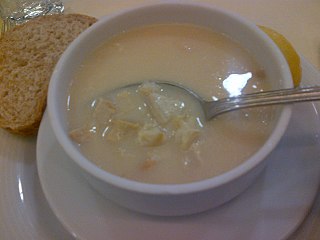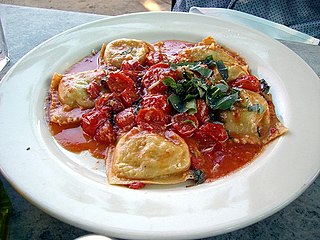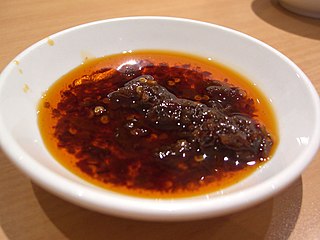
Mexican cuisine consists of the cooking cuisines and traditions of the modern country of Mexico. Its roots lie in Mesoamerican cuisine. Its ingredients and methods begin with the first agricultural communities such as the Maya who domesticated maize, created the standard process of maize nixtamalization, and established their foodways. Successive waves of other Mesoamerican groups brought with them their own cooking methods. These included: the Olmec, Teotihuacanos, Toltec, Huastec, Zapotec, Mixtec, Otomi, Purépecha, Totonac, Mazatec, Mazahua, and Nahua. With the Mexica formation of the multi-ethnic Triple Alliance, culinary foodways became infused. Today's food staples are native to the land and include: corn (maize), beans, squash, amaranth, chia, avocados, tomatoes, tomatillos, cacao, vanilla, agave, turkey, spirulina, sweet potato, cactus, and chili pepper. Its history over the centuries has resulted in regional cuisines based on local conditions, including Baja Med, Chiapas, Veracruz, Oaxacan, and the American cuisines of New Mexican and Tex-Mex.

Tzatziki, cacık, , or tarator is a dip, soup, or sauce found in the cuisines of Southeast Europe and the Middle East. It is made of salted strained yogurt or diluted yogurt mixed with cucumbers, garlic, salt, olive oil, sometimes with vinegar or lemon juice, and herbs such as dill, mint, parsley and thyme. It is generally served as a cold appetizer (mezze) or a side dish.

Veracruz, officially known as Heroica Veracruz, is a major port city and municipality on the Gulf of Mexico in the Mexican state of Veracruz. The city is located along the coast in the central part of the state, 90 km (56 mi) southeast of the state capital Xalapa along Federal Highway 140.

Tripe soup, tripe stew or tripe chorba is a soup or stew made with tripe. It is widely considered to be a hangover remedy.

The chile relleno is a dish in Mexican cuisine that originated in the city of Puebla. In 1858 it was described as a "green chile pepper stuffed with minced meat and coated with eggs".

Spaghetti alla puttanesca is an Italian pasta dish invented in Naples in the mid-20th century and made typically with tomatoes, olive oil, olives, capers, and garlic — with vermicelli or spaghetti pasta.

Sofrito, sofregit (Catalan), soffritto, or refogado is a basic preparation in Mediterranean, Latin American, Spanish and Portuguese cooking. It typically consists of aromatic ingredients cut into small pieces and sautéed or braised in cooking oil.

Manti, also manty, mantu or manta, is a type of dumpling popular in most Turkic cuisines, as well as in the cuisines of the South Caucasus, Central Asia, Afghanistan, Balkans, Bukharian Jews and Chinese Muslims. Manti are also consumed throughout Russia and other post-Soviet countries, where the dish spread from the Central Asian republics. The dumplings typically consist of a spiced meat mixture, usually lamb or ground beef, in a thin dough wrapper and either boiled or steamed. Size and shape vary significantly depending on the geographical location. Manti resemble the Chinese jiaozi and baozi, Korean mandu, Mongolian buuz and the Tibetan momo and the dish's name is cognate with the Korean mandu, Chinese mantou and Japanese manjū, although the modern Chinese and Japanese counterparts refer to different dishes.

Tunisian cuisine, the cuisine of Tunisia, is a blend of Mediterranean and Berber cuisines. Its distinctive spiciness comes from the many civilizations which have ruled the land now known as Tunisia: Romans, Vandals, Byzantines, Arabs, Spanish, Turkish, Italians (Sicilians), French, and the native Punics-Berber people. Many of the cooking styles and utensils began to take shape when the ancient tribes were nomads. Nomadic people were limited in their cooking implements by what pots and pans they could carry with them. The Tunisian tagine is very different from the Algerian or Moroccan dish. It is a type of a pie dish, made out of eggs, meat and vegetables, similar to the Italian frittata or the eggah.

Many cuisines feature eggplant salads and appetizers.

Marinara ("mariner's") sauce is a tomato sauce usually made with tomatoes, garlic, herbs, and onions. It can include the addition of capers, olives, spices, and a dash of wine as possible ingredients in its many variations. This sauce is widely used in Italian-American cuisine, which has diverged from its Old World origins.

The term acqua pazza is used in Italian cuisine to refer to a recipe for poached white fish, or to simply refer to the lightly herbed broth used to poach it. There are many different variations of this sauce, from light broths, to thick tomato based sauces, which have been found on all types of seafood, and even chicken. This dish is comparable to other Italian dishes, such as: cioppino, cacciucco and guazzetto.

Cappon magro, is an elaborate Genoese salad of seafood and vegetables over hardtack arranged into a decorative pyramid and dressed with a rich sauce.

The cuisine of Veracruz is the regional cooking centered on the Mexican state that stretches over most of the country's coast on the Gulf of Mexico. Its cooking is characterized by three main influences, indigenous, Spanish and Afro-Cuban, due to its history, which included the arrival of the Spanish and that of slaves from Africa and the Caribbean. These influences have contributed many ingredients to the cooking including native vanilla, corn and seafood, along with rice, spices and tubers. How much the three mix depending on the area of the state, with some areas more heavily favoring one or another. The state has worked to promote its cuisine both in Mexico and abroad as part of its tourism industry.

Shredded beef is a preparation of beef that features in dishes from various cuisines. Shredded beef is sometimes prepared using beef brisket and chuck roast. Pot roast is also sometimes shredded.

Chili oil is a condiment made from vegetable oil that has been infused with chili peppers. Different types of oil and hot peppers are used, and other components may also be included. It is commonly used in Chinese cuisine, East and Southeast Asia and elsewhere. Particularly popular in Sichuan cuisine, Hunan cuisine, and Shaanxi cuisine it is used as an ingredient in cooked dishes as well as a condiment. It is sometimes used as a dip for meat and dim sum. It is also employed in the Korean Chinese noodle soup dish jjamppong.

Chahan, also known as Yakimeshi, is a Japanese fried rice dish prepared with rice as a primary ingredient and myriad additional ingredients and seasonings. The dish is typically fried, and can be cooked in a wok. Chahan may have originated in the 1860s from Chinese immigrants arriving at the port of Kobe. Chahan is a staple food in homes in Japan. A variation of the dish is takana chahan. Some restaurants outside Japan serve the dish as a part of their fare.



























